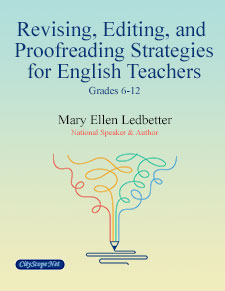Revising, Editing and Proofreading Strategies for English Teachers - E-Book © 2021
 This book provides teachers with exercises that help students understand that true revision often involves restructuring on a "deep" level. This might mean anything from recasting whole paragraphs to adding more elaboration, explanation of textual evidence, and checking for coherence in their reasoning. Editing, on the other hand, usually focuses on sentence structure, word choice, voice, avoiding pitfalls such as slang or clichés, choppy sentences, redundancy, and others. Finally, Proofreading is checking for grammatical and mechanical errors that detract from a paper's overall effect. All three steps in the process come with student-friendly, easy-to-implement skills sheets specifically designed to make student essays come "alive" and achieve exemplary scores. You will not be disappointed.
This book provides teachers with exercises that help students understand that true revision often involves restructuring on a "deep" level. This might mean anything from recasting whole paragraphs to adding more elaboration, explanation of textual evidence, and checking for coherence in their reasoning. Editing, on the other hand, usually focuses on sentence structure, word choice, voice, avoiding pitfalls such as slang or clichés, choppy sentences, redundancy, and others. Finally, Proofreading is checking for grammatical and mechanical errors that detract from a paper's overall effect. All three steps in the process come with student-friendly, easy-to-implement skills sheets specifically designed to make student essays come "alive" and achieve exemplary scores. You will not be disappointed.
| Revising, Editing and Proofreading Strategies for English Teachers (E-Book) | Details |
|---|---|
| Subjects Covered | Revising, Editing & Proofreading |
| Grade Levels | Middle School, High School, 6 - 12th |
| Total Pages | 138 |
| Format Available | |
| Price | $29.95 |
Order using Paypal or Credit Card:
Ordering By Phone or Order Form
Please NOTE: The E-Book will be emailed to you after we receive your funds. Please allow 1-2 days to process. Each E-Book is sent to the Teacher's email account for their classroom use only.
Revising, Editing and Proofreading
Many students think that once their rough draft is completed, the next step is checking the spelling (if that) before the final copy is ready for their teacher's evaluation. The problem, of course, is that they have skipped three vital steps in the writing process: revising, editing, and proofreading.. Usually, it is safe to say, that it is not by choice but by lack of understanding of what these stages entail. This e-book defines the terms, gives young writers practice in each, and helps them achieve more sophisticated essays.
Revising
Revising Revising is the most difficult phase in that it usually means students need to "step back to re-see" their work. In doing so, they realize that they might need to restructure entire paragraphs.
- Does their introduction have a hook and thesis?
- Does each body have a topic sentence, necessary transitions, and sufficient elaboration/support for each point?
- Is there a cohesiveness that the reader can follow?
- Does the conclusion have a "re-hook" and restatement of the thesis not in the same terms?
If not, it's back to the drawing board with the help of input from their peers and teacher.
Editing
Editing can actually be fun as it is the point at which the writer can check that his/her voice is evident and works toward maintaining the "flow" of the paper. Students know when their papers are "boring," but often they don't know how to rectify the situation. With practice in figurative language inclusion, sensory imagery, and specific word choice, and more, even the most reluctant student can see an immediate improvement. They are then ready to move to checking for tone consistency, choppy sentences/sentence combining, redundancy, adages and clichés—anything that will detract from the overall effect of their essay.
Proofreading
Proofreading can be done in stages with the help of partners or groups of peers. Papers should be checked for everything from run-ons and fragments to subject/verb agreement and pronoun usage. This e-book contains exercises in all areas of grammar/mechanics that will make students confident when turning their final essays in for a well-deserved stamp of approval.



